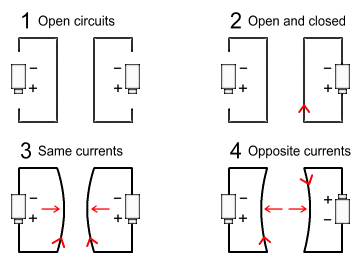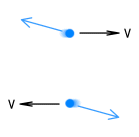Magnetism Explained
In the above diagram:
2. In experiment 3, on what grounds can we say that current is flowing in either wire? From the view-point of the batteries, electron motion is certainly occurring. But from the view-point of electrons in each wire, the electrons in the other wire are motionless. In other words, there is no velocity difference between the electrons and therefore, we would not expect magnetism to occur. This diagram shows the equivalence:
Clearly there is more to magnetism than meets the eye. Below I will attempt to explain just how it might occur in terms of electrical forces.
Using Coulomb’s Law to predict magnetismIn an earlier chapter on relativistic mass, I proposed that electrical forces between charged particles depend not only on their charge and distance, but also velocity. I then proposed a modification to Coulomb’s law, called Velocity Dependent Coulombs Law (VDCL) that incorporated velocity into the equation. Basically the force between charged particles is proportional to the cube of the difference between their velocity and the field velocity, i.e.
Where F is force, v is velocity and c
is the field speed that is equal to light speed. Let’s see how this applies to moving
electrical currents.
The electron experiences an attractive force from each of the protons. Let the force from the first proton be F1 and from the second be F2. If the electron is travelling at velocity v, what will the forces be? For simplicity we will replace the proportional sign with an equal sign:
In this case the velocity term is positive for F1 and negative for F2 because the directions are different. To calculate the net force we take the difference between these forces, ignoring vector (directional) calculations for now. For example, suppose that v is 1% of light speed (0.01c), we can calculate the net force as:
Notice that the difference between F1 and F2 is larger than the difference between their velocities, which is 0.02. That is because the cube (the 3rd power) increases the larger number more quickly than the smaller number. This is important because it means that the net force F is now greater than it would have been if the electron was not moving. In other words it appears that the force between the particles has increased due to their movement. Could this increase in the electrical force be related to magnetism?
Currents in the same directionLet’s look more closely at the situation with force between currents running in the same direction. The above example was a simplification because it did not take into account the various forces from both the positive and negative charges in the other wire. Consider the below diagram that shows a pair of parallel wires carrying identical currents:
Both wires contain equal numbers of protons and electrons. As expected, the protons stand still while the electrons freely move in the same direction. For simplicity I have shown only a single electron in the bottom wire. The below diagram shows the various forces on this electron:
The blue lines show forces from the above electrons. These forces will be exactly symmetrical because the electrons are motionless relative to one another. The red lines show forces between the protons and the bottom electron. Notice that the backward force is very strong and the forward force is quite weak due to the VDCL discussed above. Putting all these force vectors together, the net force will look like this:
The net force on the bottom electron is upward and to the left. If we were to determine the net force on a top electron we would find that it is downward and to the left:
The result of this is that the two wires will force themselves together,
just as we observe in experiment 3.
Currents in the opposite directionNow let’s look at what happens when currents run in an opposite direction. Consider the below diagram that shows a pair of parallel wires carrying identical but opposite currents:
This is more complex than when currents move in the same direction because the electron in the bottom wire is moving in opposite directions to both the protons and the electrons in the top wire. The important point here is that the speed difference between electrons is twice as great as that between the protons and the electron. As a result the net force between electrons will much greater than between the protons and the electron. The below diagram shows the various forces on the bottom electron:
Note the following:
The net force on the bottom electron is downward and to the right. If we were to determine the net force on a top electron we would find that it is upward and to the left:
The result of this is that the two wires will force themselves apart, just as we observe in experiment 4. Like the previous example, the electrons also experience a backward force against their direction of travel. Again, this will not cause the wires to recoil; it will only create a resistance to the electrons’ movement through the wires. In this case the backward force is greater and may be felt as an ‘inductive resistance’. But the only force each wire feels is a repulsive force directed at right angles away from the other wire.
ConclusionUsing the VDCL we can see how electrically charged particles may interact
in a way that produces forces in directions precisely corresponding to the forces of
magnetism. Once we understand the velocity dependent nature of electric forces, we can
predict how magnetic effects follow from it. Additionally, related effects such as
magnetic induction can be predicted. |












